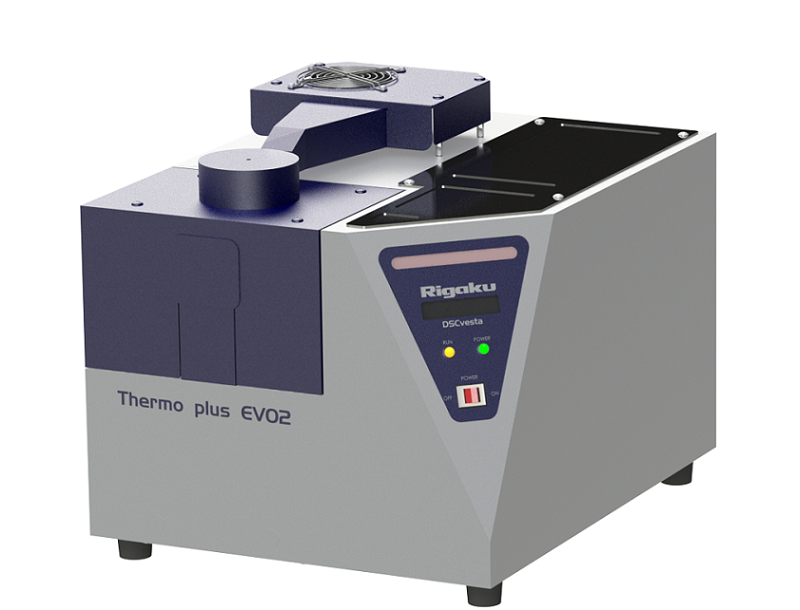Dynamic DSC
Temperature modulated DSC
A conventional constant-rate heating is combined with a sine wave (sinusoidal temperature modulation), which enables the separation of overlapping reactions and the straightforward determination of heat capacity.
With STA, measurements can be performed up to 1500°C.*¹
- Separate observation is achievable
Even when enthalpy relaxation, glass transition, and recrystallization overlap, they can be distinguished from each other. - Your current DSC can be upgraded
Upgrades are available for your DSC and STA.
Compatible instrument DSC: DSCvesta2, DSCvesta, DSC8231
STA: STAvesta, TG-DTA8122 - Modulation period as low as five seconds is supported!
Frequency-resolved analysis and more can be done with higher accuracy (maximum period of 200 seconds). - Easy specific heat capacity measurement
Specific heat capacity measurement is made easier compared to conventional DSC measurements. - Easy-to-read data
By utilizing the non-reversible DSC zero shift function, the analyzed data can be easily visualized and separated.
Measurement Examples
◆DSC Measurement
Dynamic DSC Measurement
Sample: Pharmaceutical substance
Heating rate: 3°C/min., Cycle: 36 sec., Amplitude: 0.43°C

Dynamic DSC measures with a sinusoidal temperature amplitude in addition to the constant heating/cooling rate. The obtained measurement results (left figure) can be separated into three DSC curves: the average of one cycle (DSC total), the component that follows the sinusoidal wave (DSC rev.), and the component that does not follow the sinusoidal wave (DSC non-rev.). In the analyzed results (right figure), the DSC total shows an endothermic peak at 61°C, and exothermic peaks at 77°C and 110°C, indicating no glass transition. However, the DSC rev. shows a shift in glass transition at 60°C. Since the glass transition is a change in heat capacity, it appears in the reversible component, DSC rev. Through dynamic DSC measurement, it is possible to separate and confirm the glass transition, which may overlap with non-reversible reactions such as enthalpy relaxation or crystallization in constant heating rate measurements.
Dynamic DSC Heat Capacity Analysis

With Dynamic DSC, it is possible to calculate the heat capacity of a sample through analysis. By measuring a reference material, such as sapphire (Al₂O₃), under the same conditions as the sample, and calibrating the results with DSC rev., the heat capacity of the sample can be determined.
◆STA Measurement
Dynamic DSC Measurement with STA(TG-DSC)
Sample: Silica (SiO2), powder
Heating rate: 5°C /min, Cycle: 60 sec, Amplitude: 2°C

Quartz is stable as α-quartz at room temperature and pressure, but it is known to undergo a phase change to β-quartz when the temperature changes, as follows:
α-quartz → 573°C → β-quartz
The dynamic DSC function of TG-DSC enables measurement of specific heat capacity (Cp) over a wide temperature range, which could not be measured with conventional DSC.
| Heating / cooling rate | 20°C /min (max) |
| Temperature amplitude | 0.02°C to 5°C (Setting resolution: 0.01°C) |
| Modulation period | 40s*2to 200s (Setting resolution: 1s) |
| Measurement temperature range*1 | Depending on the instrument type and specification of the furnace |
*1 Maximum heating temperature depends on the specifications of the electric furnace.
*2 The modulation period can be set from 5 seconds, but for periods shorter than 40 seconds, temperature control may not be achievable.

Compatible Products
DSC8231
Quantifies the energy changes in reactions such as melting, transition, crystallization and glass transition temperature.
View moreDSCvesta
DSC is a thermal analysis technique that quantifies the amount of energy in a reaction.
View moreDSCvesta2
DSC with industry-first self-diagnostic feature and industry's highest temperature range
View more
Contact Us
Whether you're interested in getting a quote, want a demo, need technical support, or simply have a question, we're here to help.



